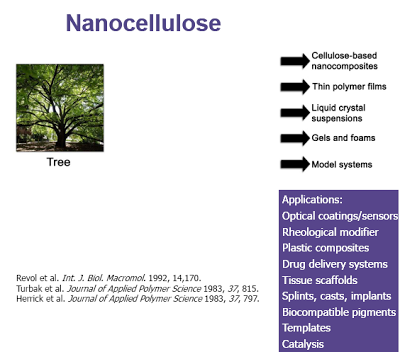New Scientist – Nanocrystalline cellulose (NCC), which is produced by processing wood pulp, is being hailed as the latest wonder material. Japan-based Pioneer Electronics is applying it to the next generation of flexible electronic displays. IBM is using it to create components for computers. Even the US army is getting in on the act, using it to make lightweight body armor and ballistic glass.
To ramp up production, the US opened its first NCC factory in Madison, Wisconsin, on 26 July, marking the rise of what the US National Science Foundation predicts will become a $600 billion industry by 2020.
NCC transparent but it also has eight times the tensile strength of stainless steel due to its tightly packed array of microscopic needle-like crystals. Even better, it’s incredibly cheap.
Mechanical testing of thin film nanocellulose material (34 pages)
Nanocrystal cellulose has a young’s modulose of 100 to 140 GPa.
Nextbigfuture first covered nanocrystalline cellulose in July 2011.
The $1.7 million factory, which is owned by the US Forest Service, will produce two types of NCC: crystals and fibrils.
Production of NCC starts with “purified” wood, which has had compounds such as lignin and hemicellulose removed. It is then milled into a pulp and hydrolysed in acid to remove impurities before being separated and concentrated as crystals into a thick paste that can be applied to surfaces as a laminate or processed into strands, forming nanofibrils. These are hard, dense and tough, and can be forced into different shapes and sizes. When freeze-dried, the material is lightweight, absorbent and good at insulating.
“The beauty of this material is that it is so abundant we don’t have to make it,” says Youngblood. “We don’t even have to use entire trees; nanocellulose is only 2 nanometres long. If we wanted we could use twigs and branches or even sawdust. We are turning waste into gold.”
The US facility is the second pilot production plant for cellulose-based nanomaterials in the world. The much larger CelluForce facility opened in Montreal, Canada, in November 2011 and is now producing a tonne of NCC a day.
Theodore Wegner, assistant director of the US factory, says it will be producing NCC on a large scale. It will be sold at just several dollars a kilogram within a couple of years. He says it has taken this long to unlock the potential of NCC because the technology to explore its properties, such as electron scanning microscopes, only emerged in the last decade or so.
NCC will replace metal and plastic car parts and could make nonorganic plastics obsolete in the not-too-distant future, says Phil Jones, director of new ventures and disruptive technologies at the French mineral processing company IMERYS. “Anyone who makes a car or a plastic bag will want to get in on this,” he says.
In addition, the human body can deal with cellulose safely, says Jones, so NCC is less dangerous to process than inorganic composites.
If you liked this article, please give it a quick review on ycombinator or StumbleUpon. Thanks

Brian Wang is a Futurist Thought Leader and a popular Science blogger with 1 million readers per month. His blog Nextbigfuture.com is ranked #1 Science News Blog. It covers many disruptive technology and trends including Space, Robotics, Artificial Intelligence, Medicine, Anti-aging Biotechnology, and Nanotechnology.
Known for identifying cutting edge technologies, he is currently a Co-Founder of a startup and fundraiser for high potential early-stage companies. He is the Head of Research for Allocations for deep technology investments and an Angel Investor at Space Angels.
A frequent speaker at corporations, he has been a TEDx speaker, a Singularity University speaker and guest at numerous interviews for radio and podcasts. He is open to public speaking and advising engagements.



